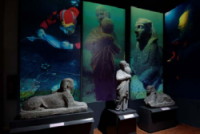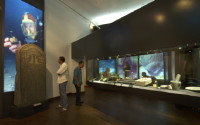
Photo. The granite priest of Osiris holding a canopic
jar (1,70m) with two sphinxes displayed at the
National
Museum of
Alexandria
.
The photos in
the background show the excavation work on the site
of Alexandria's
Eastern
Harbor.
Copyright: Franck Goddio/Hilti Foundation (www.underwaterdiscovery.org).
Photographer: Christoph Gerigk.
There are still amazing
archaeological discoveries to be made, not only in the
remains of known antique towns, but also in our own backyard or even
in the depth
of the oceans.
Franck Goddio's European Institute of Underwater Archaeology has
really proven that!
Many expect that
the greatest finds would be done under water in the future. Some of Franck Goddio's
greatest finds are now on display in the National
Museum of
Alexandria.
Based on
information from Salaction Public relations GmbH (16 March 2004), the National Museum of Alexandria in
Egypt is
newly opened. It features the most impressive historic artefacts from
Egypt and
Alexandria, including
some of the dramatic finds from the research excavations of underwater
archaeologist Franck Goddio. A separate section in the Greco-Roman part of the
museum vividly illustrates the under-water environment in which these artefacts
were discovered.
Artefacts from
the sunken site of Heracleion include the famous Stele of Heracleion and a 2,20m
statue of a Ptolemaic Queen dressed as Isis. From Alexandria's Eastern
Harbour are displayed the Priest of Osiris holding a canopic jar and two
sphinxes, one of which is a representation of Ptolemy XII, father to the Great
Cleopatra VII. Other exhibits include ritual offerings, utensils, gold and
jewellery.
|
Photo. The famous Stele of
Heracleion, granite 1,95m, in the fascinating environment of the newly
opened National Museum of Alexandria.
Copyright: Franck Goddio/Hilti Foundation (www.underwaterdiscovery.org).
Photographer: Christoph Gerigk. |
 |
The stele had
been ordered by Pharaoh Nectanebo I (378-362 BC) and is almost
identical to the Stele of Naukratis in the Museum of Cairo.
A 1929 Italian-style mansion, situated on Fouad Street that
houses the museum, was fully renovated after the Ministry of Culture had bought
it from the American Consulate in 1997. Displaying 1,800 pieces of art, the
Museum spans Alexandria's
transformation from prehistoric and Pharaonic times to the later Greco-Roman,
Coptic and Islamic periods. The interior design was done by Maurizzio de Paulo.
Other artefacts from the archaeological underwater excavations of the Institut
Européen d'Archéologie Sous-Marine (IEASM), under the leadership of Franck
Goddio, are displayed in the Museum of the Bibliotheca Alexandria.
All missions are
performed in cooperation with the Supreme Council of Antiquities,
Egypt, and
are made possible by the Hilti Foundation.
Now it's possible to
experience the underwater world where many great treasures are displayed. This
museum is definitely worth to visit if you like great adventures and learning
about the past.
Stein Morten Lund, 4 April
2004
Additional information
Franck Goddio is
one of the leading pioneers of modern maritime archaeology. His unique systems
approach to archaeological underwater excavations and close partnerships with
local authorities have led Goddio's research missions to extraordinary findings
of unmatched historical value.
In the early
80's Franck Goddio founded the Institut Européen d'Archéologie Sous-Marine
(IEASM), of which he is currently president. Working in partnership with the
Supreme Council of Antiquities, Egypt,
Franck Goddio has been mapping and investigating the sunken archaeological
vestiges in Alexandria's
Eastern
Harbor since
1992. In 1997, he began to start additional research missions in
Aboukir
Bay and, in 2000,
discovered the ancient cities of Heracleion and
Canopus.
Archaeological research missions are under works to this date, and will be
carried on.
Franck Goddio
has also initiated and coordinated a number of shipwreck excavations including
seven Chinese junks from the 11th to the 16th centuries, two Spanish galleons
and two trading vessels of the British East India Company. Among the most
successful excavations are the San Diego (1991) whose discovery is renowned all
over the world and the Royal Captain (1999) during whose recovery from great
depth off Philippines' coast (-300 m) complex technical problems were overcome.
His work provides insight in trading routes and goods, naval architecture and
the adventures of historic figures: porcelain from
China,
militaria, gold and jewels bear witness to those past ventures.
The value of his
work has been appreciated by institutions, scientists and the public through
many exhibitions, television programs, films and publications.
For more
information:
The fascination
of history - researching the past, making new discoveries and communicating the
knowledge gained. These are the common goals shared by Franck Goddio (IEASM) and
the Hilti Foundation who makes Franck Goddio's projects possible. In 2003 the
University of
Oxford, the Hilti
Foundation and IEASM founded the Oxford Centre for Maritime Archaeology. The
Centre will offer scholarships for doctoral thesis on the ongoing archaeological
work in Egypt,
organize conferences and symposia as well as develop and implement a public
strategy.
The Franck Goddio Web
Site:
The official web site of Franck Goddio! Here you can read
about discovery of lost cities, submerged lands and ancient ships. See how
Franck Goddio and his crew explore and reconstruct the history!
Revealing the secrets of the seas is the mission of Franck Goddio. Click on the
link: www.underwaterdiscovery.org.
